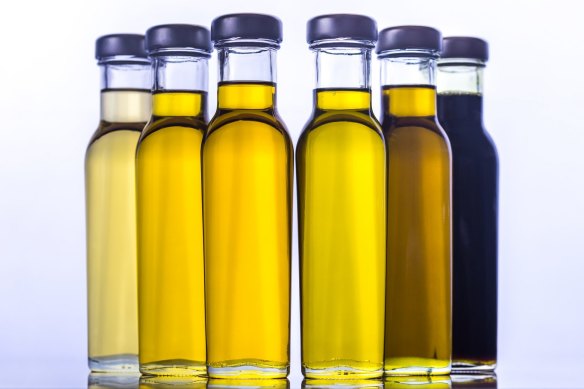Can you cook with extra virgin olive oil or just drizzle it on salads? The good oil on what to use and how to cook with it
What the best-dressed salads are wearing this season and how to ensure your fries get a golden tan.
Knowing which oil to use in cooking is part experience and part science experiment. It’s a world of monounsaturates (good), polyunsaturates (mostly good), transfats (bad) and polyphenols (great).
The secret to choosing the right one is in knowing the oil’s smoke point – the temperature at which the oil will break down and release chemicals that are good for neither your food nor for you.
If the oil starts smoking at a low temperature (see extra virgin olive oil), the oil is best for dressings and gentle cooking. If it has a high smoke point (see sunflower oil), use it for more robust pan-frying and deep-frying.
Everything else is a matter of taste – the oil’s taste, not yours.

Here’s your oil-by-oil guide
Extra virgin olive oil
Fragrant, rich, bursting with antioxidants, and minimally processed, extra virgin olive oil tastes of its olives – pungent, peppery, fruity or grassy. With a very low smoke point (also known as the burning point), it’s best in salad dressings and drizzled over vegetables, fish and seafood. Use 100 per cent Australian olive oil as an everyday luxury, and treat fine imported olive oils as the treasures they are.
Olive oil
Blended and refined to create a lighter, more stable oil; good for pan-frying rather than drizzling.
Sunflower oil
The high smoke point means it remains stable at higher temperatures – great for achieving crisp, golden deep-fried food.
Canola oil
A light, clear oil with a neutral flavour and high smoke point that makes it good for frying.
Peanut oil
Great for frying; just be aware that it does actually taste and smell of peanuts.

Vegetable oil
A collective term for a blend of oils such as canola, soybean and/or sunflower oil. A single varietal is more of a known quantity.
Grapeseed oil
A mild oil that doesn’t interfere (or add) to the flavour of your food. Often used to tone down the richness of olive oil when making mayonnaise.
Rice bran oil
Another neutrally flavoured oil, useful for frying.
Coconut oil
Good for pan-frying, grilling and roasting when you want coconut flavour, for example, in curries, satay and fried Asian snacks. Also good in granola and desserts. Because it becomes solid at room temperature, virgin coconut oil is a great vegan substitute for butter.
Avocado oil
Good for frying, grilling and roasting, with a gentle buttery flavour that salads and tomatoes love. Great for dips, making mayonnaise, and drizzling over soups.
Sesame oil
A strong, fragrant, nutty oil milled from toasted sesame seeds. Adding just a few drops to rice, noodles, steamed fish and soup has a real impact.
Nut oils
Walnut, almond, hazelnut, macadamia oils are deeply fragrant elixirs that bring richness to dressings and vegetable dishes. Buy in small quantities and store in the fridge.
Tip
Pre-heat the pan before you add the oil, to reduce its exposure to high heat and retain its best qualities.
The best recipes from Australia's leading chefs straight to your inbox.
Sign up